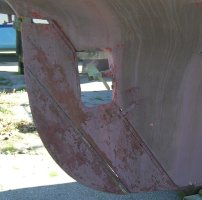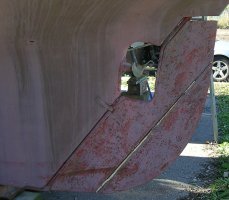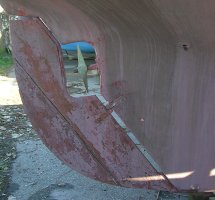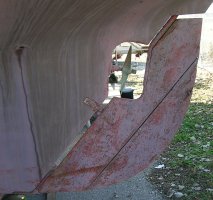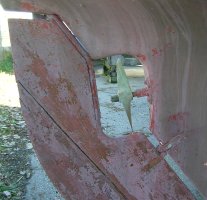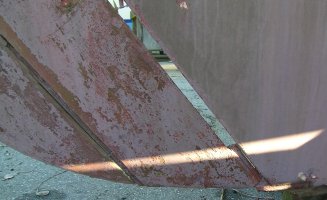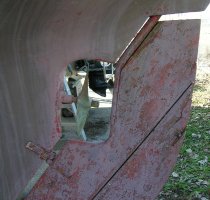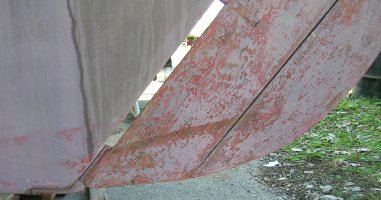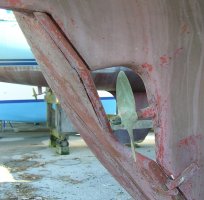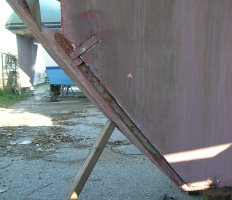It is apparent from the Maintenance Manual and also discussions on the list that there is some variation in how the Alberg 30's rudder is attached to boat. The consensus seems to be that the rudder can only be removed by removing the tiller head and the shoe on the keel and dropping the upper shaft through the hull. What is not clear is whether the earliest rudders were mounted the same way as the later rudders. There was a suggestion that one early rudder was attached to the upper shaft by rods that could be removed from the leading edge. I was hoping that because mine is an early boat that the blade could be removed without going through the process of removing the shaft as well.
In order to determine the extent of the damage I spent some time poking and prodding to see how the rudder is constructed and attached to its shafts. The following is what I have found: The rudder is made of several pieces of wood (mahogany?) that have been edge joined with splines to reinforce the glue joints. At first glance the blade seemed to be hung on two shafts; the upper one coming from the tiller down and around the back of the prop opening and the lower that appeared to start at the bottom of the prop opening and extended to the shoe on the rear of the keel. Photos 1 & 2 shows the damaged rudder. A seam has separated and a previous owner attempted to make repairs using braid and liquid caulking. Unfortunately the repairs only made matters worse since the expanding braid appears to have widened the gap. Removing the braid/caulking and cleaning the seam allowed the gap to be substantially reduced (Photos 3 & 4) by tapping the trailing edge of the rudder with a piece of 2 X 4. I suspect that the gap can be further reduced using clamps. As has been mentioned in the Maintenance Manual, and on the list, the rudder blade is attached to the two rudder posts by bolts of various lengths which run to the trailing edge of the blade and terminate with washers and nuts. Closing the seam revealed that the nut on at least one of the upper shaft bolts (the lowest one) had been "dragged forward" into the wood of the blade. This had created an apparent "blister" in the wood surface. The surface of the "blister" was easily removed but it and the surrounding wood did not appear to be rotten. This damage can be seen in Photo 4 on the trailing edge of the blade opposite the bottom of the upper rudder shaft.The leading edge of the lower half of the rudder is not a continuous shaft as it first seemed but is a combination of pieces of wood trim, a pintle and gudgeon and a short lower shaft that inserts via a pin into the shoe on the keel. The two pieces of wood "trim" were barely held in place by rusty wood screws. Both pieces of trim had been manufactured using a router bit to create a semicircular leading edge to the rudder.
With the trim pieces removed, photos 5, 6, 7 & 8 clearly show the mounting hardware that attaches the rudder to the hull and shafts. An examination of the trailing edge of the blade shows 5 triangular pieces of a hard filler material that cover the nuts at the end of the various rods. By extending lines from them so that they form a perpendicular with the shaft it is possible to locate the heads of the rods. Photos 9 & 10 are close ups of the top and bottom of the leading edge of the rudder with the blade turned almost 90 degrees to port. In Photo 9 three carriage bolt heads can be seen in the leading side of the upper shaft. Without digging into the blade it is not possible to say whether the rods are threaded for their entire length. In Photo 10 it seems that the rods that attach to the lower shaft do not pass through the shaft but may be blind threaded as mentioned in the manual. Looking at the way the rudder is currently mounted it seems to me that it could be easily removed without dropping the upper shaft down through the hull. The first step is to remove the nuts from the three rods holding the blade to the upper shaft. If the rods are threaded through the shaft it should be possible to back them out. If they are not threaded then they should pull out. The rudder needs to be turned hard to port or starboard to accomplish this step. Next remove the two pieces of wood trim from the lower portion of the blade. Then the fastenings that attach the pintle to the blade need to be drilled or driven out. Finally by lifting the blade a couple of inches and pivoting the top to the rear it should be possible to remove the bottom pin from the shoe. The rudder would be replaced by reversing the steps. The pintle would be reattached to the blade using bolts and nuts to make it easier for future removals.I am interested in hearing what other owners think of this potential solution. Regards,
- Varieties of Rudders
- Tiller
- Tiller Head
- Articulated
- Rudder Post
- Gudgeons & Pintals
- Rudder Shoe
- Repairs
- on Rocinante, #69
- on Sun Spur, #235
- on Quasar, #495
- Cape Horn Windvane
- Crevice Corrosion in underwater stainless steel
- Boat Maintenance
- Spars, Sails & Rigging
- Hull & Deck
- Deck Gear
- Steering
- Mechanical Propulsion
- Electrical
- Head
- Plumbing
- Accomodations
- Tools
- disorganized

